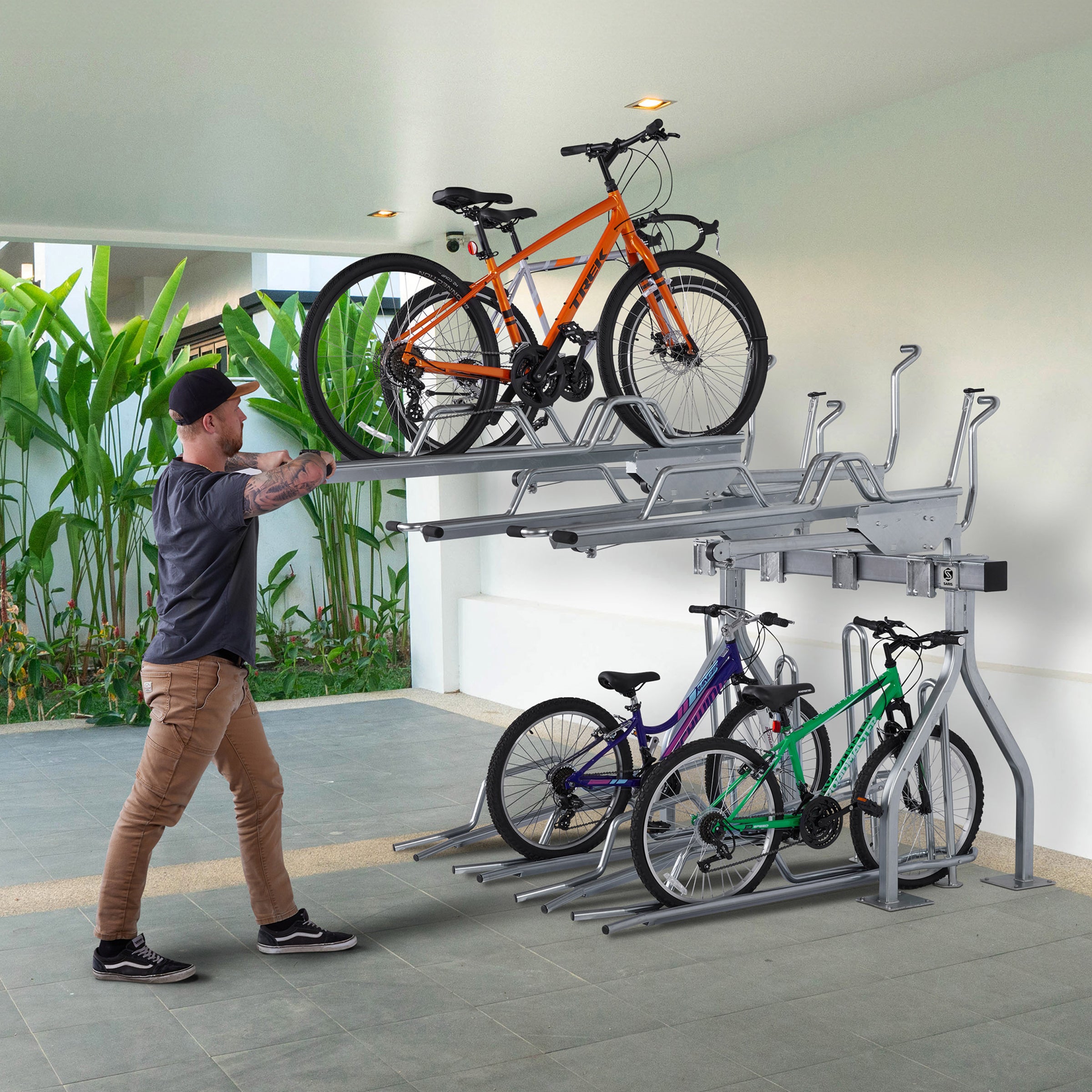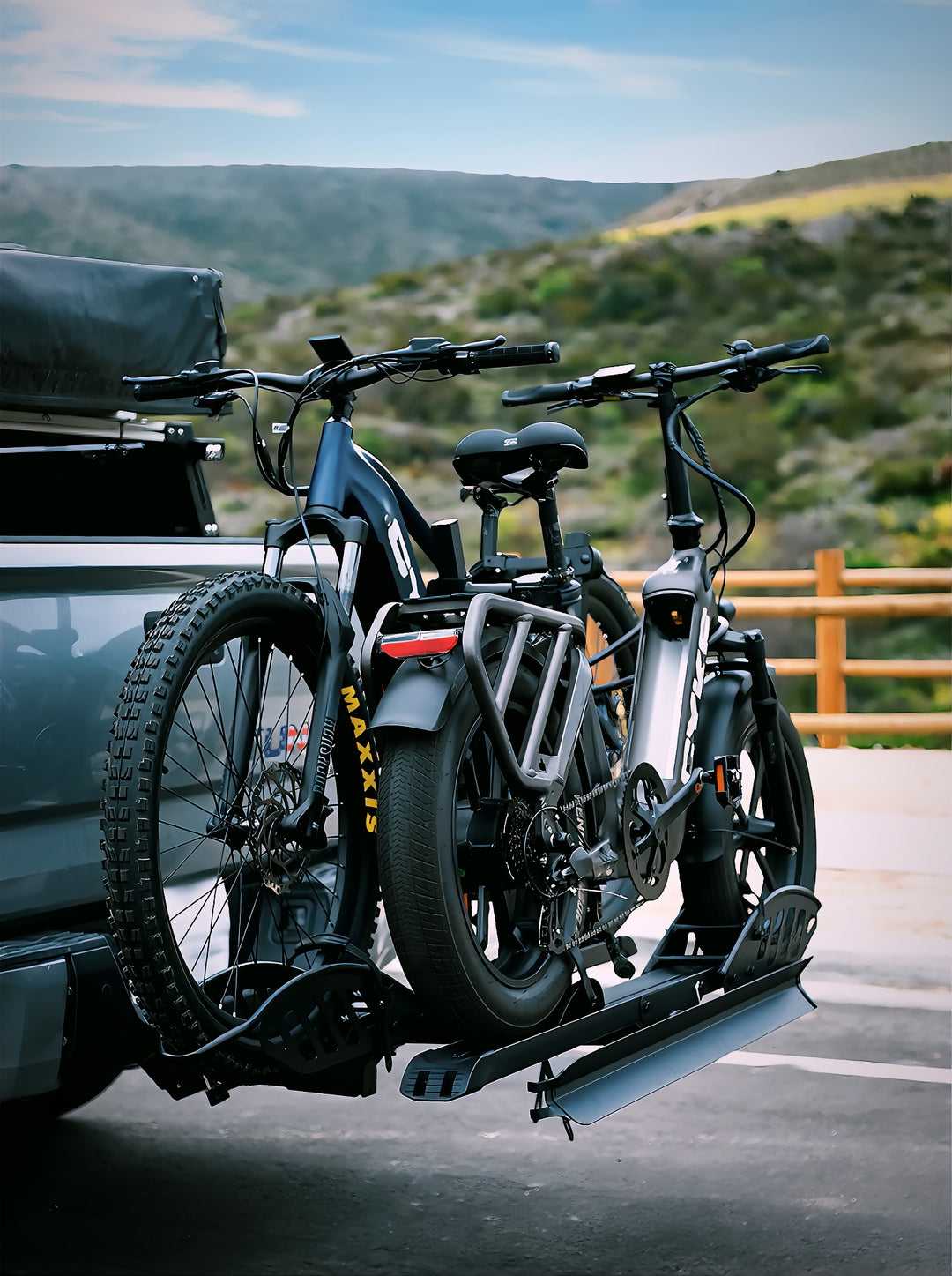How a Bike Rack Encourages Green Transportation
Wiki Article
Explore the Different Kinds Of Bike Shelf and Their Practical Applications for Cycling Enthusiasts
The selection of bike Racks offered today accommodates the diverse needs of biking enthusiasts. From freestanding to wall-mounted options, each layout uses one-of-a-kind benefits for storage space and transportation. Portable Racks likewise provide adaptability for those on the action. However, selecting the optimal kind needs cautious consideration of specific demands. Understanding these factors can make a significant difference in both convenience and safety for bikers. What are the essential considerations when picking a bike rack?Comprehending Bike Shelf Enters
Various sorts of bike Racks accommodate the diverse requirements of bikers. Among one of the most common are freestanding shelfs, frequently found in metropolitan areas, which allow several bikes to be safeguarded in a compact space. Wall-mounted Racks offer those with minimal flooring room, offering an effective option for home storage. Furthermore, portable bike racks, made for simplicity of transportation, interest bicyclists who frequently take a trip.
Hitch-Mounted Bike Racks
Hitch-mounted bike Racks supply a sensible service for transporting bicycles, but comprehending their installment procedure is necessary for reliable usage. Customers must likewise think about the weight capability of these Racks to assure security and stability while traveling. Furthermore, compatibility with different automobile kinds plays a substantial duty in establishing the best rack for individual requirements.Installment Refine Summary
When picking a hitch-mounted bike shelf, recognizing the installation procedure is important for ensuring security and benefit. Initially, the individual must validate compatibility in between the automobile and the shelf's drawback receiver. A lot of Racks are developed for either 1.25-inch or 2-inch receivers. After choosing the appropriate rack, the setup begins with protecting the shelf right into the hitch receiver and tightening up the drawback pin or screw to avoid motion. Correct alignment is essential to determine the rack does not block tail lights or permit plates. When set up, it is suggested to inspect for stability by applying small stress to the shelf. Adhering to the supplier's instructions will assure a successful installment, advertising a secure biking experience when traveling.Weight Ability Considerations

Compatibility With Vehicle Types
Picking the appropriate bike rack entails verifying compatibility with numerous lorry kinds. Hitch-mounted bike Racks are designed to attach to the back drawback receiver of a lorry, making them ideal for a large range of suvs, vehicles, and trucks. Nevertheless, it is necessary to inspect the drawback course and weight capacity to validate an appropriate fit. Most hitch-mounted Racks work with 1.25-inch and 2-inch receivers, accommodating vehicles outfitted with suitable lugging capacities. Additionally, individuals need to consider their lorry's elevation and layout, as some Racks might block back gain access to or call for additional clearance. Eventually, understanding lorry requirements validates that biking lovers can firmly deliver their bikes without jeopardizing safety or performance.Trunk-Mounted Bike Racks
Trunk-mounted bike Racks offer a sensible remedy for bikers looking for an effective way to move their bikes. Recognizing the installation process is essential for suitable use, as inappropriate setup can bring about security problems. In addition, thinking about the weight capability of these Racks warranties that they can safely hold the bikes without threat of damage or failure during transportation.Setup Process Summary
Numerous cycling lovers value the ease of trunk-mounted bike Racks for their convenience of usage and convenience. The setup process normally starts with unloading the rack and acquainting oneself with its elements. The majority of Racks come with flexible bands and hooks made to secure them to the vehicle's trunk or hatch. Individuals must confirm the rack is positioned properly, straightening it with the vehicle's contours for security. Adhering to the maker's guidelines, the bands are then tightened up safely, assuring a tight fit. It's essential to examine that the shelf does not obstruct the vehicle's lights or license plate. Lastly, verifying that all links are protected prior to packing bikes is crucial for safe transport. Proper setup boosts both safety and effectiveness during biking trips.Weight Ability Considerations
When taking into consideration a bike rack for transporting bicycles, weight capability is a vital aspect that can not be forgotten. Trunk-mounted bike Racks typically have weight limitations that differ relying on the design and layout. It is vital for users to check these requirements to assure they do not exceed the advised weight, as doing so can jeopardize both safety and vehicle stability. The majority of trunk-mounted Racks can sustain a couple of bikes, with a combined weight ability ranging from 70 to 120 pounds. Bikers need to Hitch Bike Rack additionally consider the weight of their bicycles, especially if they own much heavier models like electrical bikes. Effectively matching the shelf's weight capability with the bikes' weights assures a safe and risk-free transport experience.Roof-Mounted Bike Racks
Roof-mounted bike Racks offer a structured remedy for transferring bicycles, giving bicyclists with the advantage of taking full advantage of freight area. These Racks are created to hold bikes securely atop the lorry, permitting simple accessibility to the rear of the vehicle and preventing blockages to the permit plate or tail lights. They are suitable for individuals that often take a trip with their bikes, as they can accommodate numerous bike styles and dimensions.Installation commonly includes attaching the shelf to the car's bars, making sure a risk-free and stable fit. Roof-mounted Racks are frequently aerodynamic and light-weight, which can cause improved gas efficiency contrasted to other sorts of racks. Nonetheless, users should consider the height of their car when loading and discharging bikes, in addition to possible obstacles when entering garages or low-clearance areas. In general, roof-mounted bike Racks use a reliable and flexible alternative for serious cyclists on the go
Wall-Mounted Bike Racks
Wall-mounted bike Racks offer an effective remedy for cyclists seeking to take full advantage of restricted area while safely saving their bicycles. These Racks are optimal for metropolitan occupants or those with little garages, as they raise bikes off the ground and make use of upright room. Made from strong materials, wall-mounted alternatives can suit different bike types, including road, crossbreed, and hill bikes.Installment is uncomplicated, enabling customers to mount them in garages, basements, or perhaps outdoor rooms. Lots of styles permit one or numerous bikes, making them functional for private or household use. Furthermore, some wall-mounted Racks included incorporated locks or protection attributes to prevent burglary, boosting assurance for bicyclists.
Portable Bike Racks
Portable bike Racks supply bicyclists a flexible and convenient option for transferring their bikes. These Racks are created for simple installment and elimination, making them suitable for those who require to frequently switch between places or automobiles. Compact and usually lightweight, portable bike Racks can be easily saved in a trunk or garage, reducing the concern of long-term installations.There are different sorts of mobile bike racks, consisting of hitch-mounted, trunk-mounted, and roof-mounted alternatives, each satisfying various vehicle kinds and biker preferences. Hitch-mounted Racks give security and accessibility, while trunk-mounted Racks are usually more versatile and economical. Roof-mounted Racks are wonderful for optimizing cargo space however might require some lifting.
Selecting the Right Bike Shelf for Your Demands
Exactly how can one determine the ideal bike shelf to fit their certain cycling needs? Identifying the ideal bike rack includes reviewing numerous variables. One must consider the kind of car made use of for transport, as Racks are designed for various installing systems, such as trunk, drawback, or roof covering. Next off, the number of bikes to be lugged is important; some Racks accommodate only one, while others can hold numerous bikes effectively. Additionally, establishing the weight and framework style of the bikes is significant, as particular Racks are much better matched for heavier or distinctly designed bicycles. Intended use needs to be taken right into account; frequent vacationers may favor an extra mobile choice, while occasional customers might focus on simpleness and ease of setup. By carefully evaluating these factors to consider, people can select a bike shelf that meets their demands and improves their biking experience.
Often Asked Questions
Can Bike Racks Accommodate Different Bike Sizes and Styles?
Bike Racks vary in style, making it possible for lodging for various bike sizes and styles. Some Racks include adjustable components, while others are especially tailored for sure bikes, making sure safe storage space and easy accessibility despite the bike's specs.Just how Do I Effectively Protect My Bike on a Rack?
To effectively secure a bike on a rack, one need to ensure the framework and wheels are tightly attached utilizing locks or bands, looking for security and stopping movement throughout transport to stay clear of damage.Are Bike Racks Easy to Get Rid Of and set up?
Bike Racks differ in setup intricacy, yet many are developed for user-friendliness. Detachable models typically provide straightforward setup and elimination, while long-term installments may call for devices and more time, depending on the certain style.
What Products Are Bike Racks Normally Made From?
Bike Racks are normally made from materials such as steel, light weight aluminum, and plastic. E Bike Rack. Steel provides longevity and strength, while light weight aluminum supplies light-weight mobility. Plastic alternatives are frequently designed for ease of use and costDo Bike Racks Affect Gas Efficiency When Driving?
When driving is considerable, the inquiry of whether bike Racks influence gas effectiveness. Studies indicate that bike Racks can raise aerodynamic drag, possibly causing reduced gas efficiency, especially at higher speeds or with extra weight.After choosing the suitable rack, the installation begins with securing the rack into the drawback receiver and tightening the hitch pin or screw to prevent movement. Roof-mounted Racks are commonly wind resistant and lightweight, which can lead to enhanced fuel performance compared to various other types of shelfs. Hitch-mounted Racks offer stability and ease of access, while trunk-mounted Racks are usually extra affordable and versatile. Next, the number of bikes to be lugged is necessary; some Racks suit just one, while others can hold numerous bikes effectively. Bike Racks differ in style, enabling lodging for different bike dimensions and designs.
Report this wiki page